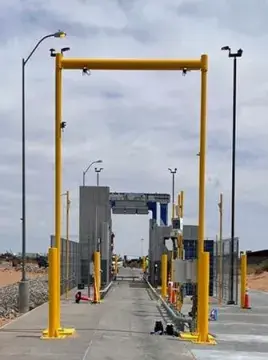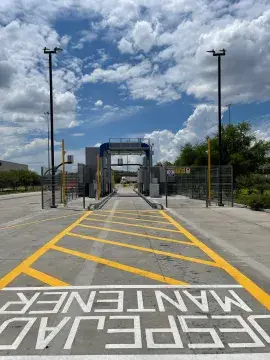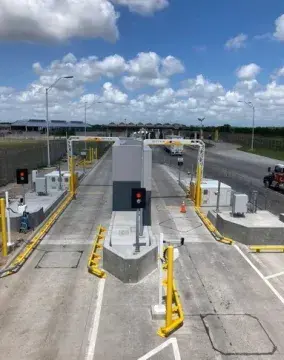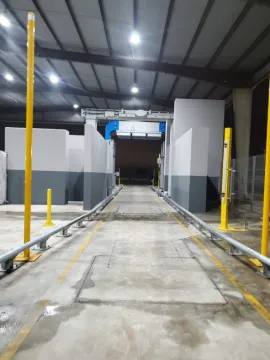
Multi-Energy Portals have shown recent success in increased volume and efficiency of cargo scanning at U.S. ports of entry—including an August 2023 $1.5 million drug seizure in Santa Teresa, New Mexico.
Every year, millions of cargo containers make their way to U.S. ports of entry (POE) via maritime, roadways, and railways. According to U.S. Customs and Border Protection (CBP), more than 100,000 commercial cargo trucks cross U.S. POEs daily. Tasked with securing and maintaining the integrity of the nation’s borders, CBP is responsible for ensuring that all cargo is fit to cross U.S. borders—that is, free of illegal contraband. To combat the threat of human and drug trafficking, it is imperative that their methods for cargo screening and physical examination are as thorough as they are efficient.

The sheer daily volume of incoming commercial trucks and cargo means that any technology solution deployed by CBP needs to be able to support high-volume scanning (cab and cargo) in a timely fashion and without impeding commercial trade operations. Traditional protocols target “suspicious” trucks after a primary, less comprehensive search for further screening, which either requires cargo be transported offsite to a warehouse for a more intensive examination or have a mobile scanning unit brought in to do the job—a slow and often arduous process that creates a window of vulnerability to would-be traffickers. Those not deemed suspicious wouldn’t undergo the secondary screening necessary to discover concealed contraband. Recognizing the vulnerabilities in this process, CBP enlisted the Science and Technology Directorate (S&T) to close the gap.
Taking a scientific approach to cargo screening

CBP began the acquisition process for technology that would improve their commercial truck screening process back in 2018. Bringing in S&T meant that CBP could leverage not only an evidence-based technical approach to addressing current and emerging threats and challenges, but also S&T’s expertise in bringing various partners, both interagency and commercial, to the table to develop innovative solutions. The five-year Multi-Energy Portals (MEP) Test and Evaluation Project was launched with the goal of developing a system that could handle the traffic flow at U.S. POEs, increase scanning volume, and decrease the time it takes for CBP to clear trucks. Having a common viewing platform would also streamline how CBP trains personnel to analyze and adjudicate images.
S&T worked with industry partners to conceptualize, build and test five fixed, multi-energy drive-through prototypes consisting of a low-energy scan for occupied cabs and higher X-ray scan for cargo. As vehicles pass through, the MEP is used to detect possible trafficked people and contraband, including bulk currency and illicit drugs like fentanyl. The team also introduced a common viewer workstation to centralize command center operations, and this just the beginning.
“This project increases the overall security of commercial shipments into the country,” said S&T POE Program Manager John Clemmensen. “It allows for the scanning of all shipments coming into the country, which increases safety on many levels—from agricultural, to counterfeit products, to the fentanyl crisis.”
“The older system couldn’t handle the traffic flows that we currently see across the border,” he continued. “The new system is faster and able to handle the commercial flow. It’s been a successful transition and partnership with CBP’s Non-intrusive Inspection Technologies program.”
In recent months, the MEP team has conducted site visits and preliminary integration and implementation of the five upgraded systems at four POEs: Brownsville and Laredo, Texas; Nogales, Arizona; and Santa Teresa, New Mexico. As of June 2023, the first round of site acceptance tests (SATs) at each location has been completed—a major milestone for S&T and CBP. So far, the MEPs are delivering just what both agencies intended to accomplish: increased efficiency of screenings at higher scanning volumes. Current results indicate a 56% increase in vehicles scanned at POEs, while simultaneously reducing the total time for a vehicle to cross the border.
“This is certainly the technology that will get us to 100% scanning,” said Clemmensen of the goal to ensure that 100% of cargo vehicles crossing the border are scanned by the MEP system for illegal contraband in an efficient manner.
With technology in place, S&T is looking to manage the data

As work continues, the MEP team will focus on addressing two main challenges: big data and human error. With individual POEs seeing thousands of vehicles a day, a massive amount of data is being generated that needs to be analyzed. Analysis at this volume is manpower-intensive and therefore may be prone to human error; however, MEP stands ready to rise to the occasion. S&T is looking to the future, leveraging emerging technologies to expand capabilities and ease maintenance costs and resource constraints.
“We are providing training and staffing, but data management is also prime for algorithm or artificial intelligence development to support CBP operators,” said Clemmensen.
As part of the ongoing MEP efforts, CBP will receive in-progress algorithm work, identifying numerous threats and empty cargo trailers, improving detection efficiency and effectiveness. Currently, work is in progress to develop two different algorithms—one for threat detection and another to indicate whether a trailer is empty. The latter is directly in response to the Brownsville POE processing high percentages of empty incoming trailers. In early August, S&T staff traveled to Vista, California, for a factory demonstration of the empty cargo algorithm and will virtually demo the threat-based algorithm at the end of September. Algorithm development is expected to wrap up in October 2023.
Following acceptance testing, moving towards daily use and operation

“The SATs were the endpoint of five years of research and development work, and we’re pleased to see the positive results in such a short time,” said Clemmensen. “All the problem solving, figuring out traffic patterns, coordinating logistics, working through all the problems that come from installing a new piece of equipment. The SATs are the culmination of that, it’s the proof that all our solutions worked.”
In fact, in August, the Santa Teresa POE reported a drug seizure worth more than $1.5 million during two separate trafficking attempts of various contraband, including methamphetamine, cocaine, and fentanyl.
MEP site teams are working to mitigate discrepancies identified during preliminary SATs in preparation for follow-up tests, bridging the gap from the current conditional acceptance status to final acceptance at these four locations. Following the SATs, each site entered a one-year operations and maintenance period, during which CBP and S&T will conduct operation testing and gather data for future improvements. Three out of the four sites plan to enter final acceptance by the end of August, with the remaining site aiming for end of September; at this point, all sites will be fully transitioned to CBP for MEP operations.
Ultimately, the goal is to bring MEP systems to all U.S. POEs.

